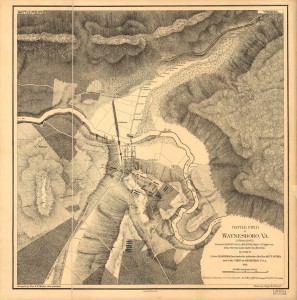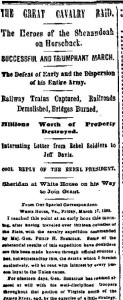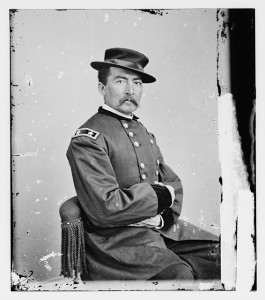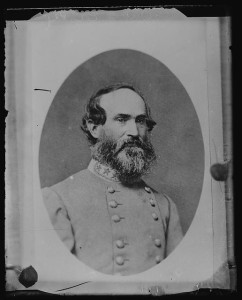Some time after the Union Army of the Shenandoah captured most of Jubal Early’s rebel force at the Battle of Waynesboro, Union General Sheridan sent Major Compson of the 8th New York Cavalry to Washington, D.C. to deliver captured battle flags and other information to the War Department. A veteran of 8th who was working as a journalist for a Rochester, New York paper used the flag report to highlight the courage of Major Compson and his regiment. The Rochester correspondent apparently got his information from friends still serving in the field.
From a Seneca County, New York newspaper in March 1865:
The Eighth N.Y. Cavalry.
A correspondent of the Rochester Union of Wednesday says: A telegraphed announced yesterday that Major H.B. Compson had been honored as the bearer of dispatches from White House to the Secretary of War, and had brought with him 17 battle flags, of which seven were the trophies of his own valor. But it did not say what was known to the writer, and kindled in the reading his pride in the fame of his old regiment, viz: that Maj. Compson was in command of the 8th N.Y. Cavalry, and that to the 8th, with the 22d, was assigned the duty of charging on Gen. Early’s cannon, three pieces of which commanded and raked the highway: [;?] that Major Compson gave the 22d the ground on his right and left, and chose the post of honor for the 8th and himself – placed Sergeant Kehoe with the flag with which Rochester friends had honored the regiment by his side, and then called on his staunch cavalrymen of the 8th to follow him, saying to his color-bearer, “Sergeant, we’ll lose the flag this time or bring more flags back along with us!” and charged fiercely down the highway in the teeth of the battery. So furious and well-ordered was the charge that only time was given the enemy to reload twice before the guns were captured, and with the great good fortune of losing only one man killed (Sergt. Carr) and five wounded. Five battle flags were the prize of this exploit. Of the numbers of prisoners taken I am not informed.
The 8th has a fortune equal to its valor. Gen. Sheridan has delighted to signalize and stimulate its good conduct by lavish commendation – the coveted reward of the soldier – for discipline in camp, reliableness on picket and patrol, and heroism in the fight. Major Moore and other brave officers had months ago been mustered out with honor. From Col. Benjamin it had just parted with the most sincere and universal sorrow – as considerate of his men as he was fearless in leading them in battle. Lieut. Col. Pope, who they all knew would never shrink in danger nor forget its honor, had been ordered to recruit the regiment among us at a time when he would gladly have shared its new perils. Major Bliss was under orders in charge of new recruits at Harper’s Ferry, and yet one who was but a few months ago one of its Lieutenants, has won new honor and new commendation for it in leading it to victory, and it could have furnished others had he fallen or been absent. So much the more for Monroe [Rochester’s county] to be proud of, and for those who, though no longer summoned at its roll-call, feel as warmly as ever for its fame and its perils. All honor to Major Compson and Sergeant Kehoe.
– Major Compson is a Seneca county boy, and joined the 8th N.Y. Cavalry as a private three years ago. A good portion of his company were also recruited here at that time by the late Capt. B.F. Sisson. Maj. Compson’s friends here will be pleased to hear of his personal bravery and soldierly bearing. He has been in command of his regiment for some time past.
Seneca County Historian Walt Gable points out that Major Compson received the Medal of Honor for his heroism at Waynesboro[1]. Walt provides a more thorough description of Major Compson’s battlefield courage and points out that 15 medals of honor were awarded for the Battle of Waynesboro. Major Compson’s citation gives him credit for capturing a “flag belonging to Gen. Early’s headquarters.” Walt notes that the medal was presented on March 26, 1865. The flag was a Confederate Second National flag; it was returned to Virginia and is currently in the possession of the Museum of the Confederacy.
Captain Christopher C. Bruton of the 22nd New York Cavalry was also awarded the Medal of Honor for capturing General Early’s headquarters’ flag.
The New-York Times of March 21, 1865 covered the Waynesboro battle as Day 4 of General Sheridan’s “Great Cavalry Raid”. Originally the 8th NY Cavalry was held in reserve. After a successful flank attack helped throw the rebels into disarray, the 8th got involved in the action. From The New-York Times March 21, 1865:
The enemy were not a little surprised to see so formidable a body of flankers on their left; an attempt to form a line to meet them proved abortive; on they pressed and the enemy seeing CUSTER’s reckless fellows marching in upon them from every direction, became panic stricken, broke and ran in terrible confusion, abandoning muskets, flags and artillery. By the time they had fairly got into the Village of Waynesboro, a few rods to the rear of their works, the mounted cavalry had charged in upon them, and Yankees and rebels were all mixed up together. The First Vermont moved in from the left, the Eighth New-York on the pike, and CAPEHART with the whole of his brigade at his heels, dashed into the village, following the Eighth. The sons of the Ancient Dominion showed [???]o fight at close quarters, but surrendered promptly when ordered to do so, thereby preventing a general slaughter. South River winds its way along just in the rear of Waynesboro, and the only route for the enemy to escape was to cross this. It was not at this time fordable, and the only way for infantry to cross was by a small foot-bridge and by the railroad bridge. A few hundred attempted to escape by the latter route. Col. WHITAKER, (who with Capt. BURROUGHS and some thirty men of the Eighth New-York, were the first to cross the stream,) with a few men on horseback, cut off the men attempting to escape on the railroad track. WHITAKER with a dozen men here captured at least 300 rebels and one battle-flag. Maj. COMPSON, Capt. BURROUGHS and Capt. BENTON [Bruton?], the latter of the Twenty-second New-York, made no halt, but pressed on and beyond the mountain, capturing several officers and EARLY’s headquarter flag.






